|
|
|
Sort Order |
|
|
|
Items / Page
|
|
|
|
|
|
|
| Srl | Item |
| 1 |
ID:
110834
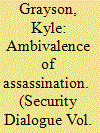

|
|
|
|
|
| Publication |
2012.
|
| Summary/Abstract |
This article begins by presenting a biopolitical account of assassination and targeted killing events carried out by liberal regimes. It argues that forms of political violence are understood and made meaningful beyond the administrative frameworks and technical rationalizations often privileged in biopolitical analyses. Deploying Alan Feldman's (1991) argument that political violence is an 'emplotted action' alongside William Connolly's (2005) notion of resonance, it provides a genealogical account of how forms of assassination have been positioned within Western cultural understandings of political violence. The focal point of examination is the biblical heroine Judith, whose story has resonated as a preferred narrative structure for understanding and (de)legitimating acts of assassination among Western publics. Through its reading of the book of Judith, the article highlights the importance of ambivalence for understanding assassination as a form of political violence. The legacy of the moral problematique enabled by Judith is then illustrated in relation to US President Barak Obama's May 2011 speech announcing the killing of Osama Bin Laden. The article concludes by suggesting that although the story of Judith may underpin contemporary assassination practices, it also offers a means of critically engaging with them.
|
|
|
|
|
|
|
|
|
|
|
|
|
|
|
|
| 2 |
ID:
120328
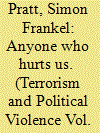

|
|
|
|
|
| Publication |
2013.
|
| Summary/Abstract |
This article examines the evolving logic to the systematic assassinations of Palestinian activists carried out by Israel during the Aqsa Intifada (September 2000-2005). It argues that the logic of Israel's "assassination policy" developed in three stages. During each successive stage, the security executive expanded the scope of who could be legitimately targeted and what goals could be served in doing so. This article further argues that normative and legal considerations played a key role in determining target selection and tactical means. It finds that during the Aqsa Intifada, the Israeli government used assassination not according to any unified purpose but rather as an evolving and often ad hoc combination of political communication, tactical action and, more rarely, strategic manipulation. In short: there was not one single rationale driving the assassinations but several.
|
|
|
|
|
|
|
|
|
|
|
|
|
|
|
|
| 3 |
ID:
038137


|
|
|
|
|
| Publication |
New York, Praeger Publishers, 1970.
|
| Description |
xlviii, 752p.
|
|
|
|
|
|
|
|
|
|
|
|
Copies: C:1/I:0,R:0,Q:0
Circulation
| Accession# | Call# | Current Location | Status | Policy | Location |
| 007227 | 364.15240973/KIR 007227 | Main | On Shelf | General | |
|
|
|
|
| 4 |
ID:
048163
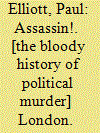

|
|
|
|
|
| Publication |
London, Blandford Book, 1999.
|
| Description |
239p.Hardbound
|
| Standard Number |
0713727594
|
|
|
|
|
|
|
|
|
|
|
|
Copies: C:1/I:0,R:0,Q:0
Circulation
| Accession# | Call# | Current Location | Status | Policy | Location |
| 042552 | 364.1523/ELL 042552 | Main | On Shelf | General | |
|
|
|
|
| 5 |
ID:
105703
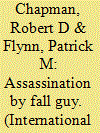

|
|
|
| 6 |
ID:
130235
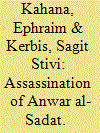

|
|
|
|
|
| Publication |
2014.
|
| Summary/Abstract |
Within the context of intelligence, the assassination of Egypt's President Muhammad Anwar al-Sadat on 6 October 1981 can be characterized as both a symbolic security failure and a failure to implement professional security principles by those responsible for guarding his life.
The circumstances creating the security "hole" were not confined to the short period preceding the assassination, but rather began long before, as part of an intense clash between two conflicting forces: extreme Islam and modern statehood.
In contrast to prevailing opinion, the apex of the struggle between these two forces is the main reason for the assassination, and not Sadat's peace with Israel. 1 The assassins of the al-Jihad group, springing unchecked from the substratum of fundamentalist Islam, carried out their work resolutely, exploiting the circumstances with almost incredible ease.
The sixth of October, observed in Egypt as a day of military triumph over the Israel Defense Forces (IDF) in the October 1973 War (the Yom Kippur War), is celebrated as an official holiday at the Grave of the Unknown Soldier on the outskirts of Cairo. On that date in 1981, on the reviewing stand stood President Sadat and his entourage: Vice President Hosni Mubarak; Defense Minister Mohammad Abu-Gazala; members of parliament; and members of the diplomatic corps, among them Israeli Ambassador Moshe Sassón.
Mirage fighter planes flew in celebratory formation above, and all in attendance were occupied with watching them and the huge parade passing before the reviewing stand, as columns of soldiers marched past the proud president.
When it was the artillery unit's turn to pass, a military truck stopped suddenly, from which four uniformed men sprang. Thinking this was part of the pageantry, no security personnel acted to prevent them from approaching the reviewing stand. One of the men quickly threw a grenade that did not explode, followed by more grenades. The assassins cocked their weapons and charged, firing at those on the reviewing stand.
The speed and suddenness with which the assassination was carried out resulted in pandemonium. People ran in all directions to take cover while Sadat stood, stiff and in shock, making him a clear target for sniper Hussein Abbas, 2 who shot him in the neck and chest. Sadat collapsed on the spot, yet this did not prevent another assassin, Abed al-Hamid, from emptying the rest of his rifle's magazine unhindered to confirm the kill. Sadat was flown by Gazelle helicopter to the Armed Forces Military Hospital at Ma'adi, but he arrived with no pulse, as his chest and arteries had been fatally penetrated.
The individual responsible for the assassination was Captain Khalid al-Islambouli. The fact that he and his partners managed to carry out this "inside job," despite explicit warnings having been received of threats on the president's life at the parade, testifies to a complete absence of common sense on the part of the Egyptian security sector.
The head of the Israeli security unit and lead investigator of the assassination, who was also responsible for Ambassador Sasson's rescue, was Avraham Rotem. According to Rotem, some members of Sadat's security detail were known to Rotem's unit personally due to previous reciprocal visits between Israeli and Egyptian personnel. 3 For this reason, the part played by Egyptian security personnel that day remains a mystery, due precisely to Israel's familiarity with them and the fact that they had acquired their security expertise from the best American instructional training. Sadat's assassination therefore raises a number of burning questions emanating from the fact that many in the upper Egyptian echelons knew that Sadat was in the opposition's crosshairs.
|
|
|
|
|
|
|
|
|
|
|
|
|
|
|
|
| 7 |
ID:
095405
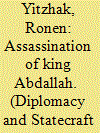

|
|
|
|
|
| Publication |
2010.
|
| Summary/Abstract |
King Abdallah was assassinated as a result of his relationship with Arab leaders. The opposition included three leaders: the Mufti Hajj Amin al-Huseini, King Faruq and Ibn Saud. Jordanian intelligence knew about the conspiracy and warned King Abdallah, but he decided to visit Jerusalem as originally planned and there he was assassinated. After the assassination on 20 July 1951, the Jordanian government was faced with two dangers that threatened the Hashemite regime in Jordan. The first, a Palestinian rebellion the purpose of which was the replacement of the Hashemite regime with a Palestinian one; the second an invasion of Jordan by either Syria or Saudi Arabia or both countries together, and their possible control of it. However, the dangers turned out to be neither tangible nor serious and the Hashemite regime remained in power.
|
|
|
|
|
|
|
|
|
|
|
|
|
|
|
|
| 8 |
ID:
044592
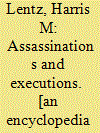

|
|
|
|
|
| Publication |
Jefferson, McFarland and Company, Inc. Publishers, 1988.
|
| Description |
xviii, 275p.Hbk
|
| Standard Number |
0899503128
|
|
|
|
|
|
|
|
|
|
|
|
Copies: C:1/I:0,R:0,Q:0
Circulation
| Accession# | Call# | Current Location | Status | Policy | Location |
| 030454 | 909.8/LEN 030454 | Main | On Shelf | General | |
|
|
|
|
| 9 |
ID:
139094


|
|
|
|
|
| Summary/Abstract |
This article examines the term ‘assassination’ as describing a certain kind of killing which may – and does – occur in warfare. It critiques current definitions of the term to synthesise a stronger and more value-neutral definition: the premeditated killing of a specific individual in order to realise political objectives. It also critiques the term ‘targeted killing’ for a comparative lack of analytical clarity. The article then presents a theory of the goals assassination may achieve and the effects it may have on a conflict environment, when occurring within a military context. The article reviews three case studies which illustrate the scope of the theory, and concludes by noting that assassination can be the subject of legitimate ethical debate, as it may potentially adhere to the norms of Just War Theory, while constituting a valid category of military action.
|
|
|
|
|
|
|
|
|
|
|
|
|
|
|
|
| 10 |
ID:
139895


|
|
|
|
|
| Edition |
1st ed.
|
| Publication |
New York, New Benjamin Franklin House, 1985.
|
| Description |
xv, 266p.pbk
|
| Standard Number |
933488432
|
|
|
|
|
|
|
|
|
|
|
|
Copies: C:1/I:0,R:0,Q:0
Circulation
| Accession# | Call# | Current Location | Status | Policy | Location |
| 025864 | 954.052/EDI 025864 | Main | On Shelf | General | |
|
|
|
|
| 11 |
ID:
153887
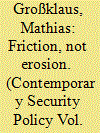

|
|
|
|
|
| Summary/Abstract |
Reframed as “targeted killing,” state-sponsored assassination is moving toward normalization. I maintain that this development can only be understood in the context of long-standing frictions between meta-norms. The regulation of assassination as an instrument of foreign policy is a normative amalgam that is connected to both state sovereignty and liberal thought. Those discursive links structure both the evolution of the norm and its transformation, as they can be invoked by actors in order to reinterpret and reshape it. As I argue, the prevalent “norm erosion” perspective fails to grasp such incremental processes in that it tends to limit its analytical view to single, narrowly defined norms and overemphasizes external shocks. I thus stress the need for a more comprehensive account of normative change that highlights the surrounding meta-norms that are able to connect single norms to their larger position within the international order.
|
|
|
|
|
|
|
|
|
|
|
|
|
|
|
|
| 12 |
ID:
171280
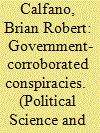

|
|
|
|
|
| Summary/Abstract |
Accusations of conspiracy are nothing new in American politics, but examples in which the government—usually cast as a key player in conspiracy theories—goes on record to corroborate that a conspiracy occurred are rare. I leveraged an experiment that randomly exposes both college-student and general-public subject pools to information about the 1979 House Select Committee on Assassination report of a probable conspiracy in the assassination of President John F. Kennedy. I find that those exposed to government corroboration of a conspiracy (1) are more prone to anger in response to the government report; (2) engage in an increased search of available media information about the assassination; and (3) are more likely to agree with the conclusion of a conspiracy in Kennedy’s murder. Implications for additional research about government pronouncements on controversial issues and follow-on public reaction also are discussed.
|
|
|
|
|
|
|
|
|
|
|
|
|
|
|
|
| 13 |
ID:
147713


|
|
|
|
|
| Summary/Abstract |
The rise of the Islamic State (ISIS/ISIL) is not well understood at this point. This paper starts by comparing the Islamic State to the Vietnamese communists in a revolutionary warfare framework and makes a causal argument that the Islamic State’s defeat of the Sahwa (Awakening) movement in Iraq was the key to its successful establishment of control of most Sunni areas and the mobilization of its population for support. Islamic State operational summaries and captured documents are used to quantitatively establish the impact of the subversion campaign against the Sahwa and Iraqi government and trace the efforts of operatives in tribal outreach and recruiting. This research provides a valuable insight into the return of a powerful method of insurgency as well as a glimpse into the vast clandestine network that provides the strength of the Islamic State movement.
|
|
|
|
|
|
|
|
|
|
|
|
|
|
|
|
| 14 |
ID:
114407
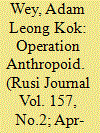

|
|
|
|
|
| Publication |
2012.
|
| Summary/Abstract |
In 1941, the very concept of a Czechoslovakian state was a parlous one: the provisions of the 1938 Munich Agreement, which had dismembered the pre-war state, had not yet been annulled. The position of the Czechoslovakian government-in-exile among the Allies was weak. The exiled president, Eduard Benes, therefore proposed a bold plan to assassinate a key Nazi leader and challenge a perception of Czech passivity under occupation. While the plan did succeed, it came at a terrible human cost. But, for Benes, it secured the pre-1938 borders of Czechoslovakia.
|
|
|
|
|
|
|
|
|
|
|
|
|
|
|
|
| 15 |
ID:
069724
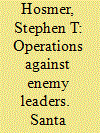

|
|
|
|
|
| Publication |
Santa Monica, Rand Corporation, 2001.
|
| Description |
xxvi, 149p.
|
| Standard Number |
0833030280
|
|
|
|
|
|
|
|
|
|
|
|
Copies: C:1/I:0,R:0,Q:0
Circulation
| Accession# | Call# | Current Location | Status | Policy | Location |
| 045182 | 327.1273/HOS 045182 | Main | On Shelf | General | |
|
|
|
|
| 16 |
ID:
082405
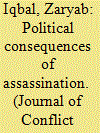

|
|
|
|
|
| Publication |
2008.
|
| Summary/Abstract |
The assassination of a political leader is among the highest-profile acts of political violence, and conventional wisdom holds that such events often have substantial political, social, and economic effects on states. We investigate the extent to which the assassination of a head of state affects political stability through an analysis of all assassinations of heads of state between 1952 and 1997. We examine the political consequences of assassination by assessing the levels of political unrest, instability, and civil war in states that experience the assassination of their head of state. Our findings support the existence of an interactive relationship among assassination, leadership succession, and political turmoil: in particular, we find that assassinations' effects on political instability are greatest in systems in which the process of leadership succession is informal and unregulated
|
|
|
|
|
|
|
|
|
|
|
|
|
|
|
|
| 17 |
ID:
132364


|
|
|
|
|
| Publication |
2014.
|
| Summary/Abstract |
After discussing the extent to which the period from 1878-1934, with its frequent incidents of anarchist assassinations and bombings, can be considered the classic age of "lone wolf" or leaderless terrorism, this article focuses on four acts of anarchist violence and police and government responses to this violence. The four cases are the 1896 bombing of a Corpus Christi procession in Barcelona, the 1901 assassination of President McKinley, a 1902 bombing in Livorno (Leghorn) Italy, and the 1912 attempted assassination of Italian King Victor Emmanuel III. Confronted by these violent acts, the authorities resorted to two basic policies that might be referred to as "micro" and "macro" approaches. The macro approach was to launch massive crackdowns, arrest hundreds if not thousands of suspects (in some cases torturing them), and pass repressive legislation limiting freedom of the press, freedom of association, and freedom of assembly in order to discover the guilty terrorists and to squelch anarchist propaganda and organized activity. The micro approach was to focus on improving the intelligence capacity of the police by modernizing and expanding it, and creating or professionalizing the protective service for government ministers and heads of state.
|
|
|
|
|
|
|
|
|
|
|
|
|
|
|
|
| 18 |
ID:
181631
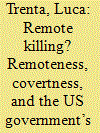

|
|
|
|
|
| Summary/Abstract |
The recent assassinations of General Soleimani and Mohsen Fakhrizadeh have renewed debates surrounding governments’ use of assassination. Some commentators have interpreted these episodes as an escalation in practices of “remote warfare.” Recently, the literature on remote warfare has expanded to include multiple activities at – and below – the threshold of war. From its original focus on geographical distance, “remoteness” now encompasses the “political” distance of deployments of force. In this understanding, “remoteness” has blurred the line separating the methods used to deploy force and the ways – overt or covert – in which they are deployed. Having highlighted the role of covertness, this article establishes that assassination should be included in the “remote warfare” canon. A study of the US government’s involvement in assassination permits us to elucidate the interplay between remoteness and covertness. The article shows that a deeper engagement with the assassination as a tool of US foreign policy provides two main advantages. First, it permits us to better historicise the “opacity” and “political distance” of practices associated with “remote warfare.” Second, it helps unveil the origins of the legal, political, and technological infrastructures that currently sustain much of the US government’s global “remote wars.”
|
|
|
|
|
|
|
|
|
|
|
|
|
|
|
|
| 19 |
ID:
153876
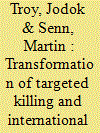

|
|
|
|
|
| Summary/Abstract |
This article introduces the special issue’s question of whether and how the current transformation of targeted killing is transforming the global international order and provides the conceptual ground for the individual contributions to the special issue. It develops a two-dimensional concept of political order and introduces a theoretical framework that conceives the maintenance and transformation of international order as a dynamic interplay between its behavioral dimension in the form of violence and discursive processes and its institutional dimension in the form of ideas, norms, and rules. The article also conceptualizes targeted killing and introduces a typology of targeted-killing acts on the basis of their legal and moral legitimacy. Building on this conceptual groundwork, the article takes stock of the current transformation of targeted killing and summarizes the individual contributions to this special issue.
|
|
|
|
|
|
|
|
|
|
|
|
|
|
|
|
| 20 |
ID:
179934
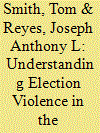

|
|
|
|
|
| Summary/Abstract |
Despite election violence being a commonly agreed upon phenomena in the Philippines, there had been a dearth in academic research in recent years, largely due to the lack of reliable sources of information. To address this, this article adapts recognised methods from studies such as Newman’s 2013 paper, together with McGrath and Gill’s 2014 research on terrorism and elections. To expose the timing of election violence, incidents were tracked relative to election dates for the period from 2004–2017, with the results indicating violence increases closer to an election date, and frequency substantially increased during the 14-year period. This is the first academic journal article since Linantud in 1998 to focus on the issue of election violence in the Philippines but through adaptive methodologies goes further to make national analysis. Furthermore, findings reveal statistically significant differences on the types of terrorist attacks and types of targets when comparing election and non-election periods. Complicating factors are explored in relation to majority of attacks attributed to ‘unknown’ actors and the complex situation during elections. The results also demonstrate that election violence in the Philippines is dominated by the New People’s Army and the use of assassination. The paper makes the case for further research and the creation of a dedicated database of election violence in the Philippines and elsewhere, and finally evaluating these few measures implemented by the government that have failed to stem election violence.
|
|
|
|
|
|
|
|
|
|
|
|
|
|
|
|
|
|
|
|
|